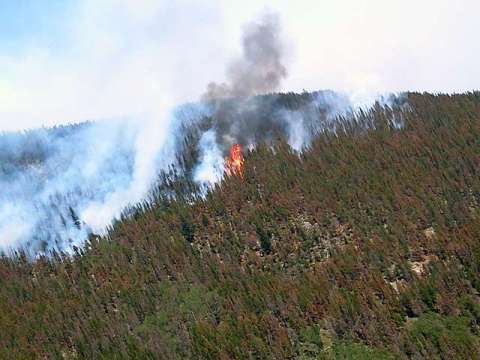“Remembering” Past Climates May Help Trees Survive in a Changing World
Source Article: Peltier, D.M.P., Anderegg, W.R.L., Guo, J.S. & Ogle, K. (2022) Contemporary tree growth shows altered climate memory. Ecology Letters, 25, 2663–2674. Available from: https://doi.org/10.1111/ele.14130
Featured Image Caption: The two-needle piñon tree is experiencing increasingly frequent and intense drought in the American Southwest. Image Source: Wikipedia Creative Commons by Ben Javelina
Ben Javelina from The Suburbs of Angels, USA, CC BY-SA 2.0 https://creativecommons.org/licenses/by-sa/2.0, via Wikimedia Commons
The Battle of Trees and Climate Change
Today, climate change is causing increasingly intense and frequent droughts. Trees can help fight climate change because they take up the carbon dioxide that increases warming of the planet. However, trees are expected to struggle given climate change, particularly due to drought.

Bryan Ungard from Santa Fe, New Mexico, USA, CC BY-SA 2.0 https://creativecommons.org/licenses/by-sa/2.0, via Wikimedia Commons
Trees grow slower when they are in stressful conditions, like droughts, and tend to grow faster in their preferred environmental conditions. But past climates can have lagging effects on growth for multiple years, meaning that the growth rate of a tree depends on not only the present environment, but also the past environments. This can be considered a “climatic memory,” the collection of past climates that are still affecting current tree growth, or that the tree “remembers.”
Given climate change, normal environmental conditions are becoming less and less common due to increasing climate variability; extreme conditions are occurring more frequently. So, if recent years are atypical, do trees consider the more distant past to determine their present growth rates?
Modeling Tree Growth
Luckily, there are records of trees’ reactions to climate: tree rings. Thin rings are left after years when the tree grew little, and thicker rings indicate that the tree grew more. Scientists investigated the tree rings of two-needle piñon trees (Pinus edulis) in the Southwestern US. These tree rings recorded growth from 1899 to 2013. Then, they built a model.

Their model estimated annual tree growth (tree ring width) based on the current and past four years of environmental conditions (temperature and precipitation). The importance of the past conditions was allowed to vary over time to fit the observed tree ring data. Then, the scientists looked at how important the past climate was for tree growth in the past versus today. If giving high importance to past climate data greatly improved the model’s ability to match the observed tree ring data, that was a sign that the trees had a long climate memory.
But wait! What if trees are just becoming increasingly or decreasingly sensitive to recent climate, not changing climatic memory? To test this alternative possibility, the scientists studied the relationships of older tree ring records to past and recent climates, then compared these relationships to those of younger tree ring records.
Trees Are Lengthening their Precipitation Memory
They found that two-needle piñon trees today are currently growing at a pace consistent with a 45-71% longer memory of precipitation and a 22-39% shorter memory of temperature than in the past. The precipitation memory in the past was about 21 months, but today is about 36 months. The temperature memory in the past was about 36 months, but today is about 28 months. The model also revealed that trees today grow slower in response to repeated droughts than they historically grew. Additionally, trees with this longer precipitation memory and shorter temperature memory are currently less likely to die!

snowpeak, CC BY 2.0 https://creativecommons.org/licenses/by/2.0, via Wikimedia Commons
As for changing climate sensitivity, tree growth in the older half of the tree ring records is just as related to the recent climate as the younger half. This means that trees are no more or less sensitive to recent climate than they used to be, and the change in tree growth patterns is best explained by the changing importance of more distant past climates.
How on Earth Does Tree “Memory” Work?
The researchers think three tree processes may have contributed to the change in climatic memory that they found:
First, during droughts, trees are susceptible to cavitation, or the formation of air bubbles that can block the tubes that carry water and nutrients throughout the trees. If trees suffer from multiple droughts back-to-back and there is cavitation during each drought, then less tree area can be used to carry water and nutrients. The tree is under increasing stress with each additional drought, and as a result, grows slower and slower.
Second, trees sometimes store energy in non-structural carbohydrates (NSCs). If a tree has a longer precipitation memory, it may be using NSCs stored in the more distant past for energy. Separately, trees may prioritize storing new NSCs during droughts, creating that long memory.
Third, tree age could be playing a role. As trees age, they become increasingly susceptible to stress by cavitation. This could also lead to slower and slower growth in response to multiple droughts.
What Might Happen Next?
The past environment can matter for how trees and other organisms live and grow in the present. Recent precipitation used to be the main driver of tree growth, but the frequency and intensity of droughts in the 21st century have changed that. Patterns of tree growth today have already been greatly altered by climate change, so what does that mean for the future? This shift to “remembering” less recent precipitation and more recent temperatures is helping trees to survive drought for now, but this is likely short-term safety. Ultimately, future droughts may become too intense to sustain these trees in the long-term.

Aside from mitigating climate change, one thing we can do for these trees in the future is careful management. Practices like grazing and fire prevention can lead to forests full of densely-packed trees. When many trees grow close together, there is less available water. It takes more water to prevent drought-like effects on the trees, so instead, we should perhaps utilize strategies to reduce forest density, like prescribed fire.
Reviewed by:

